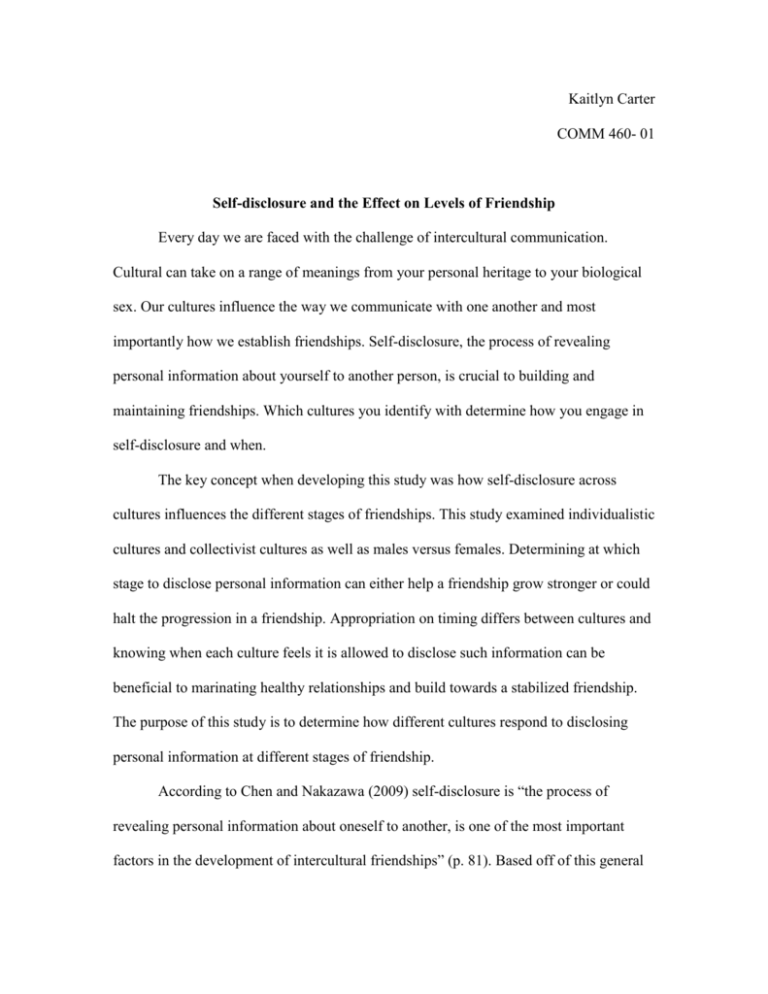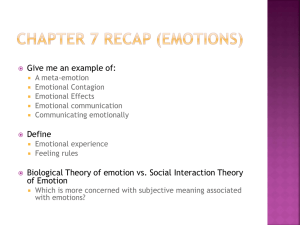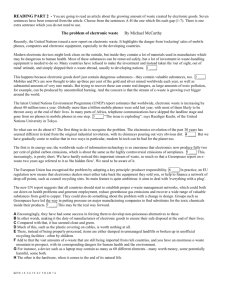thesisDraft-1 - Longwood Blogs
advertisement

Kaitlyn Carter COMM 460- 01 Self-disclosure and the Effect on Levels of Friendship Every day we are faced with the challenge of intercultural communication. Cultural can take on a range of meanings from your personal heritage to your biological sex. Our cultures influence the way we communicate with one another and most importantly how we establish friendships. Self-disclosure, the process of revealing personal information about yourself to another person, is crucial to building and maintaining friendships. Which cultures you identify with determine how you engage in self-disclosure and when. The key concept when developing this study was how self-disclosure across cultures influences the different stages of friendships. This study examined individualistic cultures and collectivist cultures as well as males versus females. Determining at which stage to disclose personal information can either help a friendship grow stronger or could halt the progression in a friendship. Appropriation on timing differs between cultures and knowing when each culture feels it is allowed to disclose such information can be beneficial to marinating healthy relationships and build towards a stabilized friendship. The purpose of this study is to determine how different cultures respond to disclosing personal information at different stages of friendship. According to Chen and Nakazawa (2009) self-disclosure is “the process of revealing personal information about oneself to another, is one of the most important factors in the development of intercultural friendships” (p. 81). Based off of this general finding, it is important to be able to understand the most appropriate times to self-disclose during different stages of friendships and with people of different cultures than our own. Background Collectivist and Individualistic Cultures When considering the verbal communication that takes place between friends, it is important to understand all influencing factors that could determine when specific individuals find it appropriate to disclose personal information. The main categories I want to focus on for my study are collectivist cultures versus individualistic cultures. In a qualitative study conducted by Mie Kito, she studied the levels of self-disclosure between four different types of friendships in both American cultures and Japanese cultures. Kito (2005) reports that American students reported self-disclosure on a higher scale than Japanese students. This is important to note when judging the appropriateness of selfdisclosure based on cultural influences. Males and Females Another main category to consider is males and females. Based on past research, masculine speech communities use a different language standard than feminine speech communities, which could potential influence when individuals choose to disclose personal information. In a qualitative study conducted by Jonathan Gore, he examined how different sexes (males and females) decided what type of information to talk about in a conversation. Gore (2009) reports that females tend to use both verbal and nonverbal cues to decide when to disclose information whereas males rely solely on verbal communication. In an article written by Shasta Nelson, she explains that developing friendships is much like developing a relationship. There are different stages one must progress through to establishing a friendship as opposed to the common myth that after one bonding experience people become instant best friends. Allan and Barbara Pease wrote a book detailing the importance of both verbal and nonverbal communication in our everyday conversations. From the times of the cavemen, before spoken language, humans communicated with hand gestures and grunts. As language evolved, people have been able to use words to describe how they feel and to lead discussions. Both elements are crucial to effective communication because while verbal communication allows us to better detail what we are trying to say, nonverbal communication allows insight to what people are feeling that they are not verbally communicating. Both Nelson, Pease, and Pease provide thought provoking insight into the important rules behind communication and developing friendships. There are stages that we must all go through to build a foundation that can develop into a friendship and we have to learn how to use both verbal and nonverbal communication to enhance the quality of our friendships. Theoretical Grounding Levels of Friendship In her book, “Interpersonal Communication: Everyday Encounters,” Wood (2011) lists six different stages of friendships but for the purposes of this study only the first four stages will be examined: 1) Role-limited interaction: the time when you meet someone for the first time. This is the very first encounter with a person where you discuss broad topics such as the weather if you are talking to a stranger or work related things if you are talking to a new co-worker (p. 257). Basic conversation during this stage consists of a meet and greet with your classmate to discuss where you come from, your hometown or your favorite color. Topics during this stage are very general. 2) Friendly relations: the stage in a relationship where you compare interests and dislikes with one other. This is when you try to find a common ground with a person to see if there is anything in your relationship that you can relate to each other with and if there is enough information worth exploring to the next stage (p. 257). Conversation during this stage pertain to more in-depth general knowledge such as family history or favorite vacations and why. 3) Moving toward friendship: moving past the interactions we do everyday based on our social rules. This is taking the friendship out of work and away from the classroom to small meetings for lunch or coffee. In this stage individuals will make minor disclosures and interactions that do not require a lot of effort (p. 257). Conversations during this stage consist of more personal information outside of a general setting (classroom or work office). This is the stage where individuals look for a common ground to form a relationship. 4) Nascent friendship: when individuals label themselves as “friends” and begin to dedicate more efforts to meeting times. During this stage patterns begin to emerge where the individuals may meet for lunch every Sunday at a certain time or get together every weekend at the local bar (p. 257). Conversations during this stage reach a much more personal level such as talking about relationships and past relationships, hopes, dreams, and aspirations. Literature Review Definitions of Self-Disclosure The idea of self-disclosure is not new to our society and therefore has been defined and redefined several times. In a qualitative study conducted by Andrea DeCapua, Diana Berkowitz, and Diana Boxer, the researchers sought to understand how females use self-disclosure to build relationships with one another. Decapua, Berkowitz, and Boxer (2006) note that once a strong friendship has already been established [between women] the conversations that take place serve more as a bonding experience rather than a getting to know one another conversation. These function to sustain and reinforce their close friendship (p. 401). Kito (2005) reports “self-disclosure is one of the most popular topics in psychology and interpersonal communications. It refers to how willing people are to discuss information related to themselves with other people. Selfdisclosure is also one of the most important factors affecting the quality of close relationships”(pg. 127). Self-Disclosure General Findings Self-disclosure is when you tell someone a personal piece of information about yourself. This is one of the most important parts in building friendships and based on previous research, once a general level of friendship has been established [between women], there process of self-disclosing is seen in the form of story telling and relating to each other’s personal stories. Many study have been conducted on how different cultures choose to selfdisclose personal information. In a study conducted by Chen and Nakazawa, 252 students (college, graduates and high school students) participated in a questionnaire to determine the influence of cultural backgrounds (collectivist or individualistic) on self-disclosure between friendships. Chen and Nakazawa (2009) found that “as levels of relational intimacy in intercultural and interracial friendships increased, self-disclosure in the six topics also increased” (p. 89). In a study conducted with all women, DeCapua, Berkowitz, and Boxer examined three different groups of women and compared their levels of self-disclosure. Group A consisted of four women who have been friends for a very long time. Group B consisted of four women who share membership in a Jewish Sisterhood. Group C consisted of four women who get together for play dates with their children. This study concluded that no matter the closeness of the women in each group, all of the women studied used narratives to form a bond with one another and reciprocated the topics and responses of the other women in the group. DeCapua, Berkowitz, and Boxer (2009) state “social relationships are developed and maintained through collaborative efforts of constructing conversation” (p. 408). In a study conducted by Jonathan Gore, fifty men and thirty women completed an interview with a member of the same-sex as the participant. The interviewer used different levels of self-disclosure (emotional disclosure or superficial disclosure) and the responses of the participants were recorded. The results of this studied concluded that men relied heavily on verbal cues from the interviewer to determine what to talk about and when to talk about different things whereas women attended to both verbal cues from the interviewer and non-verbal cues, such as a head nod or a hand gesture, to determine when and what to talk about. Gore states, “in general, women are more likely to disclose private and personal information in a conversation than men, perhaps because it fosters intimacy. Others have shown that boys and men are particularly uncomfortable expressing their feelings with other males, but men are willing to disclose feelings to another man if they believe that they will be collaborating on a future project with that person” (Gore, 2009, pg. 280). In a study conducted by Mie Kito, 145 college students from both American culture and Japanese culture were given a survey to complete in regards to comfortableness of self-disclosure between same-sex friendships and cross-sex friendships. The results of the study concluded that levels of self-disclosure were higher among same-sex friendships and among American students as opposed to Japanese students. Kito (2005) states “previous researchers have found that self-disclosure is higher in same-sex friendships than in cross-sex friendships between Japanese participants and between American participants” (pg. 130). Based off research conducted by Chen and Nakazawa, DeCapua, Berkowitz and Boxer, Gore, and Kito, as the level of friendship deepens, and moves from a superficial friendships to a more personal level of friendship, the level of self-disclosure also deepens. Self-disclosure is also reported on a higher level between same-sex friendships such as female-female and male-male. Lastly, women are more inclined to share personal information than compared to men. Collectivist versus Individualistic Cultures Cultures around the world are typically divided into two major categories which are collectivist and individualistic. Individualistic cultures focus more on the success of the individual whereas collectivist cultures focus on the success of the group as a whole. The best example of an individualistic culture is the United States. Americans are driven by self-success and achievements. Most other cultures such as China, Japan, and Korea are great examples of collectivist cultures. Chen and Nakazawa (2009) note one of the major differences between collectivist cultures and individualistic cultures are was that “as levels of relational intimacy in intercultural and interracial friendships increased, self-disclosure in the six topics also increased” (p. 89). The six topics of self-disclosure in this study were: attitudes and opinions, tastes and interests, work or studies, money, personality, and body. This results of this study yield that as individuals form closer bonds to one another, regardless of their cultural background, more in-depth disclosure will take place. Kito (2005) reports “the level of self-disclosure is related not only to the length of relationships but also relationship satisfaction... self-disclosure is also related to friendship strength among Chinese roommates. Similarly, significant positive correlations were found between participants’ liking of roommates and both their own and their roommates’ self-disclosure among American female college roommates” (pg. 129). Kito (2005) also reports that, “Japanese college students reported self-disclosure significantly less than did Americans… and both American students and Japanese students disclosed more in same-sex friendships than in cross-sex friendships” (pg. 136). Based off of Chen and Nakazawa’s research, and Kito’s research, individualistic cultures tend to disclose information more often than collectivist cultures. Both cultures however agreed that the more self-disclosure that occurred between a friendship lead to a higher relationship satisfaction between partners and friends. Males and Females In her book, Gendered Lives, Julia Wood discusses the communication patterns of a feminine speech community and a masculine speech community. She describes individuals that identify with feminine speech communities as those who “regard communication as a primary way to establish and maintain relationships with others” (Wood, 2012, pg. 129). In contrast, those who identify with masculine speech communities are those who, “tend to regard talk as a way to accomplish concrete goals, exert control, preserve independence, entertain, and enhance status” (Wood, 2012, pg. 131). The main difference between the two groups is how they use communication to form relationships and socialize with one another. Feminine speech communities are not limited to females just as masculine speech communities are not limited to males. Both techniques have their advantages in different situations. Using a feminine speech community is good when comforting a friend or establishing a relationship based off shared stories. Masculine speech is useful in a business setting and when establishing a relationship based off of common activities. Gore (2009) states that “previous research has reported significant sex differences in verbal content with women engaging in emotional disclosure and men engaging in topical or superficial disclosure” (p. 280). This study concludes that women tend to have conversations that discuss feelings and emotions about something whereas men tend to have conversations that lean towards general information or commonalities between each other. When relating to women, DeCapua, Berkowitz, and Boxer (2009) found that “women’s social conversation consists in large part of narratives that mirror or complement each other… interactional talk prevails among adult women’s conversation, regardless of the intended transactional nature inherent in the contexts, despite the degree of friendship/intimacy, and across regions” (p. 409). DeCapua, Berkowitz, and Boxer (2009) also found that “regardless of the social distance relationships and the activity, the three groups display more similarity in functional and structural alignment than differences” (p. 408). Gore (2009) reports that “for women, if another woman displayed neither verbal nor nonverbal interest in developing the relationship, she will be perceived as unsuitable for a close relationship” (pg. 293). “Women responded least favorably to their partner when she disclosed superficial information in a nonverbally distant manner” (Gore, 2009, pg. 292). “Men differed in their responses depending on the content of the information disclosed to them, regardless of the nonverbal behaviors displayed, whereas women attended to both verbal and nonverbal cues to evaluate the conversation partner and to offer their own personal disclosure” (Gore, 2009, pg. 292). In a study conducted by Joshua Ackerman, Vladas Griskevicus, and Norman Li, the researchers examined when an individual says “I love you” in a relationship, who says those three words first, and what happens when one individual says these words to their partner. The results of the study concluded that men and women responded differently to the intimate disclosure differently and for different reasons. Ackerman, Griskevicius, and Li (2011) report “men have also been found to divulge personal information more readily than do women in their initial meetings with strangers” (pg. 1080). This study is important to examine because it offers insight as to how males and females react to emotional self-disclosure which in turn could heavily influence the level of friendship across sexes. According to Gore (2009), “men may only attend to verbal cues when determining the appropriate time to disclose their own personal information” (pg. 292). Even though this study pertains to romantic relationships, the responses by both the males and females to personal disclosure is an important element to my study. Based off of the studies of Gore, DeCapua, Berkowitz, and Boxer, Ackerman, Griskevicius, and Li, and Wood’s book, women tend to rely on both verbal and nonverbal communication from their conversation partner to determine when to disclose personal information whereas men rely solely on verbal communication. Men were more willing to disclose information when their conversation partner disclosed personal information first. Finally, men are more open to posting personal information on social media sites than women but women will post more Facebook statuses about love than men. Methodology Research Proposal It is important to study how levels of disclosure influence levels of friendships to enhance communication when entering the work force or talking to members of different cultures. Becoming more culturally diverse is critical to everyday encounters. H1: Females in a collectivist culture are less likely than females in an individualistic culture to disclose personal information early on in a friendship. H2: Males in a collectivist culture are less likely than males in an individualistic culture to disclose personal information early on in a friendship H3: Females in a collectivist culture are more likely than males in a collectivist culture to disclose personal information early on in a friendship. H4: Males in a collectivist culture are less likely than males in an individualistic culture to disclose personal information early on in a friendship. H5: Females in a collectivist culture are less likely than females in an individualistic culture to disclose personal information later on in a friendship. H6: Males in a collectivist culture are less likely than males in an individualistic culture to disclose personal information later on in a friendship. H7: Females in a collectivist culture are more likely than males in a collectivist culture to disclose personal information later on in a friendship. H8: Males in a collectivist culture are less likely than males in an individualistic culture to disclose personal information later on in a friendship. Conclusion The purpose of this study is to provide insight into how different cultures respond to different levels of self-disclosure and how this in turn effects how a friendship develops as a result of the type of disclosure. This study is important to be able to understand how to effectively communication with individuals who have different cultural backgrounds which can better enhance the quality of communication and levels of friendships establish. This is most helpful in interpersonal relationships as well as work relationships. References Ackerman, J., Griskevicius, V., & Li, N. (2011). Let's get serious: Communicating commitment in romantic relationships. Journal of Personality and Social Psychology, 1079-1094. Chen, Y.-W., & Nakazawa, M. (2009). Influences of Culture on Self-Disclosure as Relationally Situated in Intercultural and Interracial Friendships from a Social Penetration Perspective. Journal of Intercultural Communication Research, 7798. Gore, J. (2009). The Interaction of Sex, Verbal, and Nonverbal Cues in Same-Sex First Encounters. Journal of Nonverbal Behavior, 279-299. Kito, M. (2005). Disclosure in romantic relationships and friendships among American and Japanese college students. Journal of Social Psychology, 127-140. Pease, B., & Pease, A. (2006, September 24). "The Definitive Book of Body Language". Retrieved October 13, 2013, from The New York Times: http://www.nytimes.com/2006/09/24/books/chapters/0924-1stpeas.html?pagewanted=all&_r=1& Wood, J. T. (2011). Interpersonal communication: Everyday encounters. Wadsworth: Monica Eckman. Wood, J. T. (2012). Gendered Lives: Communication, Gender & Culture. Boston: Monica Eckman.






